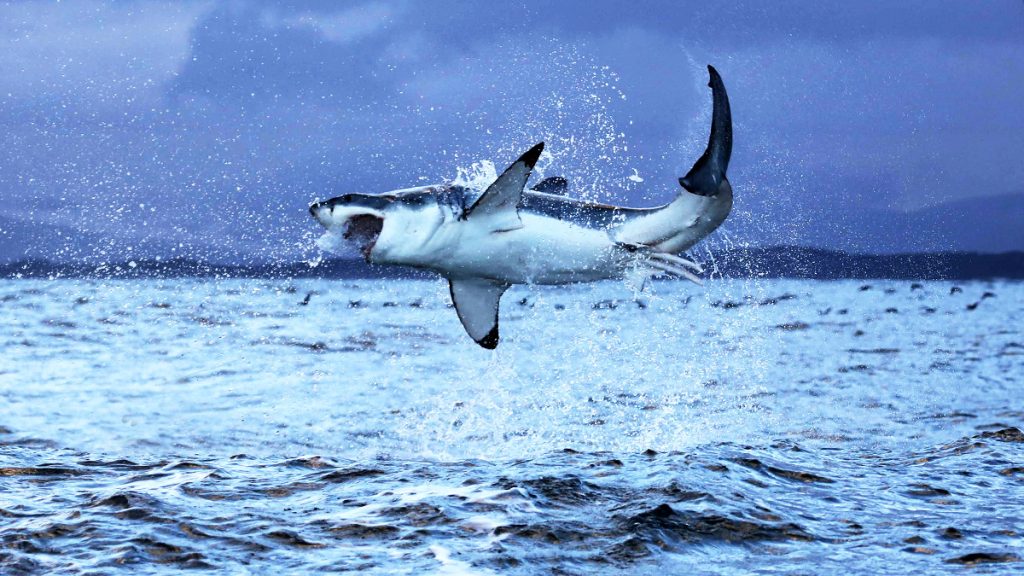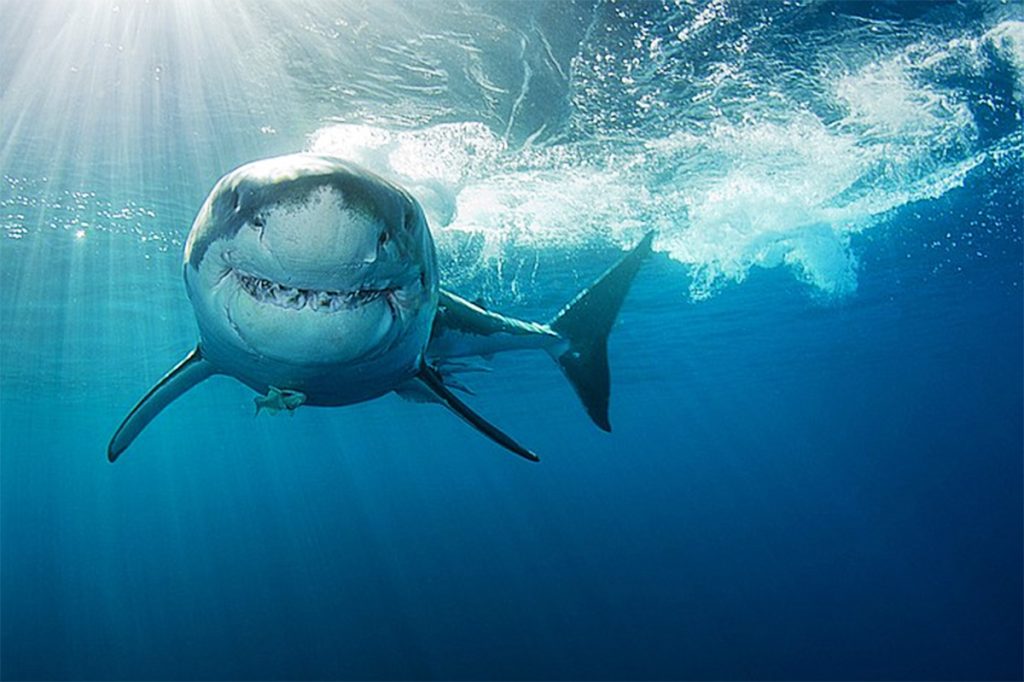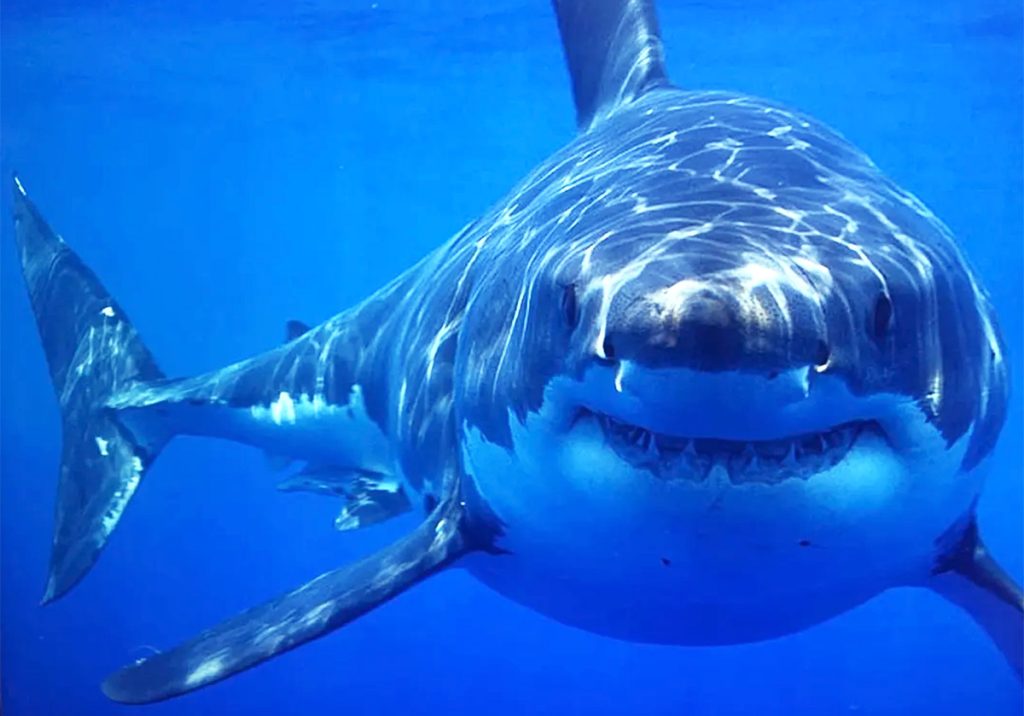The Great White Sharks of San Diego: Learning About the Ocean’s Predators

Whether you’re an avid surfer, an occasional swimmer, or hardly even get your feet wet at the beach, it’s impossible to resist the temptation of cooling off in the ocean’s healing waters on a temperate day in San Diego. But what lies beneath the waves? If you’re looking for a guide to great white sharks in California, here are some expert insights about these mysterious yet magnificent beasts and tips on how to see great white sharks in San Diego.
Shop La Jolla Artwork
Of course, we’ve all seen the dramatized award-winning thriller–Jaws–alongside other shark-related movies that have caused upheaval and worry amongst beachgoers across the globe. Yet avoiding the water due to the slim chance of getting bitten by a shark is beyond silly–it is not only infrequent to see a great white unless through an expedition or cage-diving experience, but also rare to encounter an aggressive shark.
In the last century, there have only been around 20 unprovoked shark attacks in the San Diego area, only 2 of which have resulted in fatalities. In fact, in the entire state of California, there have only been 203 reported shark incidents off the shore of the Pacific Ocean since the 1950s, 15 of which were fatalities. In other words, you are more likely to suffer injuries or fatalities from a car crash, heat stroke, or a coconut falling on your head. That’s right, a coconut. To ease your worries, we’ve gathered the down low on all things great white shark related to San Diego.
So, are there great white sharks in San Diego? In a word, yes. But there is a lot more to know about these magnificent creatures. Let’s dive in, shall we?

Table of Contents
What to Know About Great White Sharks in San Diego

The white shark, which many refer to as the great white due to its enormous strength, length, and intimidating size, has reportedly been involved in more attacks on humans than any other shark in the world. The size of a great white is startling, and they can exert incredible force. A common myth asserts that shark attacks often happen because they mistake humans for seals. However, this is generally not the case. Often the reason for shark attacks is the erratic motion of humans as they move through the water, in addition to the stark contrast between their skin and swimming apparel can befog sharks in murky or low-visibility waters. When pondering great white sharks, San Diego is the perfect place to learn, see, and experience these incredible creatures of our glorious Pacific Ocean.
Time of Year Great White Sharks Make Their Appearance in San Diego
As the weather becomes more agreeable and the Pacific becomes slightly warmer, it’s second nature to make a trip to the beach for some fun in the sun. Unfortunately, this is also the time white sharks appear in deep blue. Summer through Fall is hunting season–specifically, April through October. Great whites will come closer to the shoreline to search for sources of nutrition, with 8:00 am-6:00 pm being when sharks are most active. That said, sharks prefer to swim around the shores throughout dawn, dusk, and night. If you want to avoid feeding hours or being the main target of a shark’s snack, it is best to avoid swimming alone or at night. They don’t call it “shark week” for nothing.
Understanding Great White Shark Behavior
Because they are so elusive and ancient, it’s only natural to want to learn more about great white sharks in San Diego. Here are a few facts about shark behavior to fuel your curiosity.
Hunting Patterns and Prey Selection
Great whites employ different types of hunting strategies depending upon their type of prey. Once thought of as lone hunters, studies of a group of sharks near Baja, California, showed that they sometimes hunt in groups to nab larger prey. However, great whites mostly hunt solo by swimming below their prey. When the moment is right, they vertically swim into an attack delivering a titanic bite that will decapitate or leave a gaping hole in the prey – essentially causing it to bleed to death.
Research shows that great whites are selective eaters. One major draw for great white sharks in San Diego is the high population of sea lions. Great whites love sea lions and seals because they are high-calorie and fat-rich. While they’ll feed on fish, other sharks, octopus, and even crustaceans – they prefer to sneak up and gobble sea lions because of the highly nutritious payoff.
Interactions With Surfers and Marine Life

In general, great white sharks don’t mess with humans, but some interactions with surfers have been cited. San Diego waters are known as “aggregation sites,” which are like nurseries; it’s an ideal spot due to plentiful fish for young sharks to eat. Young sharks may appear to interact with surfers or swimmers, but in actuality, they are interacting with other fish, squid, or stingrays which they may feed upon. Sharks also enjoy these waters (around 50 – 100 yards from SD beaches) because they provide protection from predators such as mako sharks or orcas.
Natural Balance and Ecosystem Role
Great whites are apex predators. That means they play an essential part in balancing the ecosystem by keeping certain food populations in check. Sharks also help remove sick or weak marine creatures, which also helps maintain the delicate harmony of species diversity.
How to See Great White Sharks in San Diego
There are a few ways to observe great white sharks from a safe distance, including cage-diving in Guadalupe Island off of Baja, California, or taking a boat tour where you may or may not catch a glimpse of a white shark perusing around looking for their next meal. Below, we’ve listed a few ways to experience a great white up close and personal without provoking it or putting yourself at risk. If you’re feeling adventurous and want to test your wits, you can opt for snorkeling, kayaking, or swimming in La Jolla Shores as you eagerly wait to spot a great white–but don’t get your hopes up. You might be able to see other types of sharks–perhaps leopard sharks, which are more common in the area. The chances are slim, but there is always a possibility.
San Diego Shark Diving Expeditions
There aren’t a lot of options when it comes to San Diego shark diving expeditions, especially when compared with more tropical destinations. That said, off of Isla Guadalupe–more commonly referred to as the Island of the Great White Shark–you can experience a 5-6 day diving experience via luxurious and secure shark diving vessels. You can also opt to go shark cage diving, wherein you’ll be in scuba diving gear locked in safe as food is dangled nearby to draw in the terrifyingly large predator. This is one of the most remarkable ways to see a shark up close and personal, observing their gills, razor sharp teeth, and penetrating eyes a mere few feet away.
Odyssea Diving
The best possible way to experience great whites, leopard sharks, and other types of sharks is by going out on a guided tour with Odyssea Diving in San Diego. The experienced, certified divers know all the sizzling spots so you can have an unforgettable experience with these magnificent creatures. Odyssea offers scuba equipment rentals, lessons, certifications, and several different packages to fit your aquatic adventure cravings and your budget. The experts at Odyssea also offer different tours too. From exploring relics in Wreck Alley or taking a dive off Catalina Island – you’ll never forget the extraordinary sights and wonders you’ll encounter.

San Diego Shark Tour
San Diego shark tours are few and far between, with most experiences located in Mexico. That said, there are Boat tours in San Diego where you might have the opportunity to witness a shark in their natural habitat. Some offer packages where you can hop into scuba or snorkel gear with a trained professional or shark diver and venture away from the mainland towards the open water. You’ll plunge into the ocean’s depths, seemingly in the middle of nowhere, and watch in amazement as white sharks and other marine life pass you by.
Shark Sightings in San Diego
Sharks have migrated from the waters near the coast of Los Angeles toward the south, so you can potentially see a great white shark at Torrey Pines or Solana Beach, though you can sporadically spot sharks throughout San Diego at any given time of day or year. Recent shark sightings the San Diego area has reported include a local fisherman who recently spotted a 14ft great white shark–on video–preying on a seal just a few feet away from their nearby boat. In April 2017, a woman was attacked offshore in the waters of San Onofre State beach close by the Marine Corps Base Camp Pendleton, though the last deadly shark attack in San Diego County occurred in 2008 in Solana Beach.
Other shark sightings San Diego locals have since include some large great whites in September of last year in Del Mar, San Diego, and Solana Beach, which reportedly has the most sharks per capita. It ranks second, next to Florida, for the most unprovoked shark bites in the United States. While the open ocean is a more likely place to spot a shark, some pelagic shark species even pass through the bay. San Diego Bay sharks include Blue sharks, Mako sharks, Thresher sharks, Sevengill sharks, Swell sharks, Hammerhead, and Tope sharks. Bear in mind that shallower and warmer waters are desirable to sharks, and attacks can occur in as little as three feet of water.

Shop Our Selection of Local Coffee from Dark Horse Coffee Roasters
FAQs
A change in climate and an increase in seal conservation over the last several decades are two major contributions to why there may appear to be more great white shark sightings in San Diego. Summer and Fall are also hunting seasons for great whites, and their preferred prey–seals–are densely populated along the shoreline of San Diego, especially in La Jolla. Additionally, pupping and molting season for seals takes place between March to October, which naturally sharks gravitate towards. Because of heightened seal protection and shark conservation, in tandem with hunting and mating season, there is an increase in great white shark sightings in San Diego over the past couple of years.
Generally, white sharks live in mild temperature coastal waters, mainly where an abundance of fish and marine mammals reside. Many sharks live primarily in warm and shallow waters, but can also be found in colder waters in the Pacific and the Atlantic Ocean. Luckily for San Diego residents, spotting a great white shark in San Diego is like spotting a needle in a haystack. You’re more likely to find great whites in South Africa and Australia.
The largest great white sharks reportedly extend to 20ft in length, but more commonly seen are around 11-14ft. Females average approximately 15-16 feet, and white males reach up to 13ft. Shark sightings in San Diego have typically been within 12-16ft.
Decades ago, there was a brutal shark attack that happened off La Jolla Cove, where a woman was aggressively bitten by a 16ft great white, but realistically La Jolla great white shark sightings don’t happen super often. That’s not to say great whites don’t exist in the area–due to the larger concentration of seals in the La Jolla area, there is greater precedence of great whites than in other areas of San Diego, except for Solana beach.
Yes. There are roughly 1000 – 3000 great white sharks in San Diego. Furthermore, it is estimated that around 5-10 types of sharks in San Diego exist within a mile of the shore, with most being harmless unless provoked. These shark species include Leopard sharks, which tend to flock in large numbers to La Jolla Shores for the mating season each year. If you’re hoping to see great white sharks in San Diego, you’re best off booking an expedition that ensures you’ll encounter one instead of swimming out to sea in search of a shark.
The odds of a great white shark attack in San Diego are roughly 1 in 17 million, and even if there is an attack, research shows there’s a 90% chance of recovery. With these statistics in mind, we’d say it’s generally safe to swim or go diving with great white sharks in San Diego – especially on a supervised tour.
A two-year study of 26 locations on the Southern California coast revealed that great whites are present around 97% of the time in San Diego County. While white sharks are sighted year-round, they are more commonly seen during the months of August and September.
Great white shark numbers are increasing in the state of California with the highest spike in population in Monterey Bay. San Diego and Solana Beach are also known for having high populations of great whites.
Yes. If you want to swim with great white sharks, San Diego has several qualified services that specialize in getting you up close and personal with sharks in a safe, controlled environment.

The Last Word on Great White Sharks in San Diego
Great white sharks in San Diego might not be a common topic unless you plan to submerge yourself into the salty, cooling waters of the coastline, but it is something to keep in mind. We know all of this talk about great white sharks can be off-putting, but don’t let the slim possibility of seeing a great white shark in San Diego thwart you from getting your cold plunge or afternoon swim on.
Now apply that SPF and get your ocean fix!
About the author: Courtney Pester is a San Diego-based, San Francisco bred millennial with a passion for design and self-expression. She prides herself in her charcuterie board making skills and has a soft spot for animals. When she’s not pumping out articles, you can catch her playing tennis and enjoying the diversity of events and restaurants San Diego has to offer.





